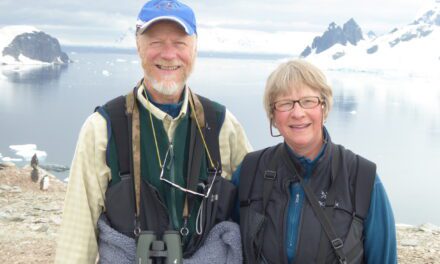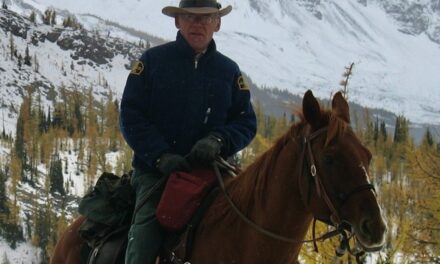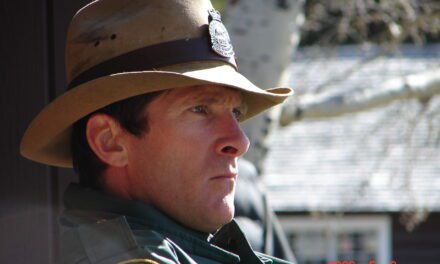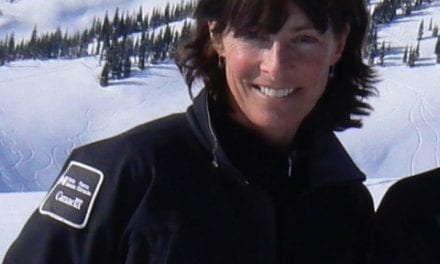This Oral History interview was funded in part by a research grant received in 2021 from the Government of Alberta through the Alberta Historical Resources Foundation.
Park Warden Alumni Society of Alberta
Oral History Phase 11 Spring 2021
Phone Interview with Janet Mercer
Date/time: March 18, 2021 11:00Am
Interviewed by Monique Hunkeler
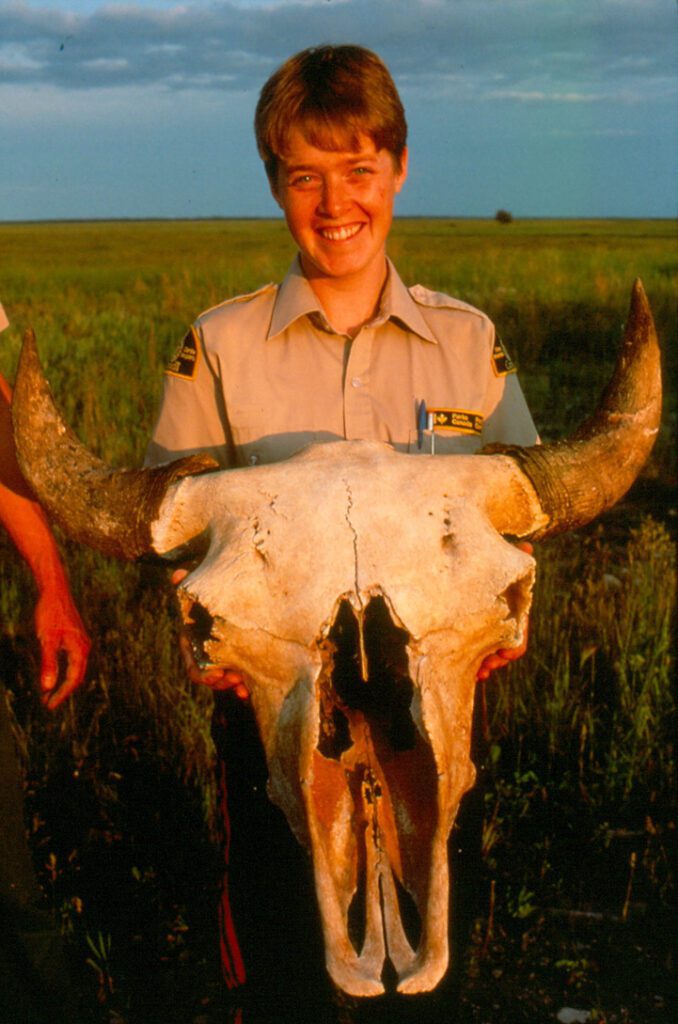
Bison Skull in Sweetgrass Delta, Wood Buffalo National Park
Place and date of birth? I was born in Amherst, Nova Scotia in 1961.
MH: Where did you grow up?
JM: I grew up in Amherst. It is a small town just on the border between Nova Scotia and New Brunswick.
MH: How did you become involved in the Warden Service? Which national park did you start working in? What made you want to join the Warden Service?
JM: I was very fortunate to get a job in 1982 as a student in the Halifax Regional Office working for the Wildlife Biologist. I was going to university at the time to start work on a Master’s in wildlife biology and was pretty ecstatic to get the job in Halifax. While I was there, I worked on projects for different Atlantic National Parks: i.e. permanent sample plot measurements in Fundy, piping plover management for Kejimkujik and Kouchibouguac. It was a great summer, I liked it so much that I decided to hold off going back to school. I ended up working through the winter because there was a medical emergency with one of the regional staff and they needed someone to help backfill the position. So they asked me if I would do it and I said, “Yeah, sure”.
I got exposed to the Warden Service when I worked in Fundy for a short period of time during that summer. It was at the time when they were trying to get women into the Warden Service. The Warden Service Coordinator for Atlantic Canada worked in the same office and encouraged me to apply for the Warden Service. What made me want to join the Warden Service was, I like diversity, and don’t like doing the same thing all the time. The Warden Service was the perfect balance of working with wildlife, outdoors, but also having responsibilities in other areas, like Public Safety, Fire and Law Enforcement. So I applied and was actually one of the first women Wardens in Eastern Canada. I started in Cape Breton Highlands in 1983. Being one of the first women in the east came with lots of challenges and hurdles because people were used to seeing it as a male role but it was also a great experience.
MH: What different parks did you work in? How did they compare? Do you have a favourite? 0500:
JM: I worked in Cape Breton Highlands National Park as a term and then seasonal Park Warden. In 1986, I got a full time position in Kejimkujik National Park. George and I got married in 1987, and moved to Wood Buffalo the same year. We were there for seven years, and I worked as a Warden during that time. From there, we went to Jasper. When we moved to Jasper, we had two young children and I took some time off to spend with them. I started working in Jasper with the Environmental Assessment shop in 1996. Once you get specialized, it’s really hard to get unspecialized if you know what I mean. So I worked in Environmental Assessment in Jasper until we moved to the Gulf Islands in 2004.
0700: You know, everyone always asked if you have a favorite and I want to say they’re all favorites, but for different reasons. Cape Breton was such a beautiful place and we had such a great team and it was exciting. There was a lot of Law Enforcement happening at the time and that was very exhilarating. It was a wonderful community to live in as well. Kejimkujik National Park was different again and I used to have to pinch myself over what I got to do. When I worked in Keji while everybody had Resource Conservation Projects, you also had backcountry patrol. During the summer, every other week, I got to spend a week in the backcountry canoeing or kayaking my district, meeting the public and making sure things were working the way they should. I used to think ‘Wow, I get paid to do this! ‘People spend their whole year working so they can come here for a week and I get paid to do this. It was really fun. Wood Buffalo was different again. Wood Buffalo is so huge; it’s bigger than Vancouver Island, almost 45,000 square kilometers. We had great Resource Conservation projects. The other cool thing about the North that I loved was, you didn’t have to look for like-minded people, they were there and you always had great people to do trips with. Starting out as a woman in the Warden Service in Cape Breton and Keji, most of my friends tended to be men, because that’s who I worked with, I found it harder to get to know women in the communities. In the North, there were a lot of strong independent women, I was able to do some wonderful fun women trips and it was so nice not to have to seek out people that wanted to do the same things. The other thing I loved about the North was people didn’t have family so you became each other’s. To this day, you may not see folks you worked with up there for years, but when you do, you seem to pick up right where you left off and that is so nice. Our next Park was Jasper and while I didn’t work as a Warden in Jasper, it was a wonderful place to work and live, and what’s not to love about Jasper?
The Gulf Islands were totally different again. The Gulf Islands is more of a piecemeal Park because it’s made up of a number of different properties, on different islands, to me, it’s more like an urban park. While the island offers a lot of things that a lot of the smaller more remote communities don’t, we do miss the wilderness aspect that places like Jasper, Wood Buffalo, Keji and Cape Breton provided. Although the boating and the boat work here was very rewarding and something I really enjoy.
MH: What were some of your main responsibilities over the years? 1245:
JM: In Cape Breton, we had a fish fence counting Atlantic salmon. A lot of resource work there focused on the fisheries, river and stream assessments; we did a lot of electrofishing. There was also wildlife work in terms of deer and moose. Cape Breton had a history of poaching in the Park, so we did a lot of Law Enforcement work predominantly in the fall, and we had a fair number of successful Law Enforcement cases. In Kejimkujik National Park, I was really lucky because I got to manage the pine marten reintroduction program which was great fun. Basically, what happened was a number of pine marten were trapped in Northern New Brunswick and then brought to the Park and at that point in time, what they liked to do was have a soft release program. That meant holding the marten in a good size containment cage for a number of weeks to get them acclimatized to their new areas so ideally, they wouldn’t ‘split Dodge’ the minute you open the cages. We collared all of the marten before they were released. I had this little Jeep and spent hours, (I used to call it martenizing), trying to locate the collared martens with the receiver. I would go all over the logging roads adjacent to the Park looking for them. It was really challenging because Keji doesn’t have a lot of relief so it was hard to actually get up high enough to try and pick up a signal to find them and because they would get into little nooks and crannies during the day when you’d be looking for them.

Electro Fishing Team Norman Wentzell, Murray Peterson, George Mercer, & myself
Cape Breton Highlands National Park
One day, we got a call from a lady in Liverpool, which is about an hour’s drive from Keji, and she says, “I’ve got this thing in my backyard, and I don’t know what it is. I thought it was a cat but it wasn’t and then I thought it was a fox, but it wasn’t that either, could you come have a look?”. On my way to her place, I was thinking okay, how am I going to get this marten out of her tree? When I arrived, the marten was hopping from tree to tree so I added some Ketaset (tranquilizer) to a piece of deer meat (which we had been feeding the martens when they were caged), and tossed it up onto a big limb. Eventually the marten took the bait, as the tranquilizer took effect the marten slowly began to fall asleep and just slid down the tree into the net, how lucky was that? As I was putting him into the travel cage, I thought to myself, “Boy is he gonna be mad when he wakes up cuz he’s right back to square one.”
1815: When I started working in Wood Buffalo I worked on the development of a newsletter about the bison disease issue. In 1988 there was a big issue about bison diseases in Wood Buffalo National Park because they had brucellosis and TB. At the time, Agriculture Canada was very adamant they should eradicate all the bison in the Park because of the diseases. While the park had contracted a writer to work on the newsletter, I was the middle person trying to find the balance between the pro-slaughter argument and the disease is a natural part of nature side. It was a real challenge because the (with) first draft, everybody from one side was super happy with it, but nobody from the other side (was ). And the second draft was kind of the other way around. By the time we got through the third draft, we finally found the happy median of providing an accurate presentation of the story.
From there, I co-managed the Bison Movement Study, where we radio collared 70 bison from different areas of the Park. One of the recommendations from the Environmental Assessment Review Panel that reviewed the bison issue was to determine how (much) movement there was between the different bison herds in the park. Because Wood Buffalo is so huge, some believed there may have been three or four distinct populations. The collaring program revealed the northern group were predominantly on their own with some intermixing with the Little Buffalo River bison and that there was a lot of mixing between the populations in the central, south and west side of the Park. When we were collaring, we’d be up and on the road by 6:00/6:30, work till about noon, trying to locate, tranquilize and collar the bison. We’d often take a bit of break in the afternoon, and go back at it in the late afternoon and early evening. We had a vet from Canadian Wildlife Service working with us, the first year we worked 14 days, 12-14 hour days. I’d come home, have supper, make lunch for the next day, get cleaned up, and then just fall into bed exhausted. But I can remember telling George: “This is so much fun, they don’t have to pay me to do this!” Every time we went out we’d learn so much about the animals: how they interacted, moved, the different behaviors of cows and bulls, it was so neat.
Wood Buffalo is such a huge Park, there were so many other things happening too. When I was acting as the Area Manager for the Fort Smith Office, I was involved in the Peace/Athabasca Delta Project and the various research projects looking at changes to water flow, seasonal flooding and vegetation response. I also worked on hunting and trapping permits, which were issued based on lineage. It seemed like the guys hated doing it and were more than happy to pawn it off on me. Basically, if you could show that your ancestry had one of the original permits to hunt and trap in the Park, then you could get a permit. We would meet with the different First Nations to go through applications, I found it really interesting. Women, for instance, could have different last names, the baptismal certificate might say for example Desjarlais while the birth certificate said Grandjambe, how’s that possible? I remember asking one of our First Nations patrolmen about it and he said: “Well, they’re the same, they’re interchangeable. Historically, they all went by the matriarch’s last name, but when the priests came, they gave them the Dad’s last name – that’s why they have 2 different last names.” I could see why the guys found it to be a bit of headache. For years after I left if there were questions the Chief Park Warden would say, “oh, call Jan. She’ll know.”
So much about the North, about any of the Parks, it was the people that were there at the time. When we got to Wood Buffalo, there were a whole bunch of young, newly married couples. We would work all day, go home, grab some supper, and then say: “Let’s go check out the peregrine nest at the Salt Plains.“…because we were also working with peregrines which were a threatened species at the time. We’d take a scope and hike into the nest site to see if there were any eggs, or we’d hiked someplace else to check out something else. When the bison collaring program was happening we would spend hours flying to locate them, (this is before GPS). We would be circling and circling in a small bush plane trying to pick up a signal, when you’re trying to narrow down their location, you’re so focused on the signal…is it coming from the right or the left because you’ve got the two receivers on either side of the plane. When you finally got a bead on them, then you had to figure out where the hell you were. A lot of the potholes lakes in the northern part of the park look the same. I remember the owner of the bush pilot company showing George his new acquisition, “Look what I have, it’s called a GPS. A Global Positioning satellite,” little did we know how much that would change our lives.
30:00 In Jasper I worked in Environmental Assessment. EA is kind of one of those love hate things. I enjoyed it because you were always learning new things. Every project brought new challenges, new things to figure out, new questions to ask and that was really great. But at the same time, it seemed like it was something not many wanted to do, so it was hard to change gears into something else. In the end though, I really liked it and knew more about sewage and septic fields than I ever thought I needed to know. Surprisingly, there are times when that knowledge is very helpful.
The other nice thing about working in Environmental Assessment in Jasper was we had a group called the line leaseholders which included companies with linear leases in the Park (TransMountain, CN, Atco (power, gas, electric). They were really great to work with because most of them wanted to do the right thing. It was kind of funny because they had it in their heads, like TransMountain in particular, that Parks wouldn’t let them maintain their line. And I’m like, “Well, hang on a minute. Why do you say we’re not going to let you maintain your line?” I said, “It’s in our best interest for you to maintain your line. We may have different opinions about when and how you do things, but we definitely want you to maintain the line.” That was the beginning of a lot of work on the TransMountain line. But rather than working on projects during the summer they switched and started doing stuff in the winter. The pipeline was built between 1946 and 1948, and it went through every wetland possible, because that was the easiest place to dig. Obviously, we didn’t want them to get into the wetlands in the middle of summer or in the fall, but doing stuff in the winter was much less disturbing because the ground is frozen, and the ducks are gone.
3415: The Gulf Islands were all together different again. It was boating and the resource work included things like eelgrass and songbird monitoring and I also worked a lot on contaminated sites here which was very interesting. The neat thing about changing Parks is you get to learn new things about different environments and habitats. On the flip side, if you stay in one area, then you get to know that area really well, there’s pros and cons both ways. But I always thrived on diversity and loved learning new things. For me, it was a lot of fun to be working in different Parks over the course of my career. I never stopped being enthusiastic. When you do, that’s when it’s time to pull the pin.
MH: What did you like / Dislike about being a warden? 36:15:
JM: I liked the teamwork. I liked the camaraderie. For the most part, you always had such a great team, and you knew that if you’re working on something, somebody had your back and I liked the diversity of the work, the skills you developed and the ongoing learning. I liked that you always worked as a team, and you were there to help each other, support each other. It was a great career. I know people who went to school purposely because they wanted to be a Park Warden but I didn’t, I just lucked out getting a really great summer job and never left.
3850: Law Enforcement was not my favorite thing. It was part of the job, it was something that you did, and if you’re going to do it, you had to do well, because you couldn’t have any success otherwise. That was the one part I could have easily left behind.
MH: What were some of your more memorable events as a Warden? 3930:
JM: All the wildlife work. That was my sugar. Towards the end of my career, I worked for National Office, but held on to the contaminated sites work mostly because nobody else wanted to do it in Gulf islands, and also because it gave me an opportunity to get out in the field. I was lucky enough to have a Manager that could appreciate that was a necessary thing and you couldn’t have people tied to their desk all the time. Every time you go out you learn something new about how things interact. But for memorable events, one of the things that sticks out for me was when we were collaring bison in Wood Buffalo National Park. It was early evening and we were on the salt plains, which is this big, vast meadow and we had just finished collaring a cow, she was so beautiful and clean. Cows were always nice to collar because they don’t wallow as much as the bulls which are usually pretty dusty and dirty. As we were standing back out of the way waiting for her to wake up, we could see the bison herd off to one side, the helicopter off to the other, the sky was a beautiful purpley blue hue and we could hear the rattling call of Sandhill Cranes in the background. Then this wolf popped his head up out of the grass just behind us and howled, then there was another howl over on the other side of us, another one across from us, another one a little ways further, then another and another. While we were working on the cow we were quietly being encircled by a pack of wolves. The hairs on the back of my neck (and probably everyone else’s) were standing straight up, it was so close and so cool. In my head I’m thinking,” Damn, we’re going to come back tomorrow and this cow is going to be toast.” The bison herd hadn’t gone very far, probably sensing the wolves presence; they weren’t going to leave until the cow rejoined the herd. Finally she got up and trotted over to the herd, which then moved off. As we walked back to the helicopter I remember thinking, “Wow, does it get any better than this? How lucky are we to have had that experience!” I remember that so clearly and vividly. It was so amazing. We did go back the next day to check on the cow and she was still alive, yeah!
MH: Can you tell me about any rescue/wildlife stories that stick out in your memory? 4425:
JM: When we were in Cape Breton, we did a lot of Law Enforcement and one evening, we got a tip that someone had seen a couple of locals up on the Cheticamp River later in the evening which was unusual. George and I took the Warden truck up to the salmon fence which was part way up the river to investigate. We parked the truck and proceeded on foot in the dark up the trail toward the salmon pools. The salmon would rest in the pools before moving further upstream and this was a good spot to poach/net salmon. We got part way up when we saw flashlights coming down so we hid off in the bushes. The people stopped before they got to us and went off into the bush on the same side we were on and then they cut through the forest on the other side of the trail out to the river. We figured that’s where they had crossed the river as the Cheticamp River forms the boundary of the Park. On the other side of the river there was an old quarry road that paralleled the river for a ways, and how they would have come up. So we beat it back down to the truck, and came down and around through the campground and then started up the other side. This was the early 1980s and our radio reception was terrible. All the time when we’re driving around we’re trying to call and get some backup because we believed we were dealing with people who were poaching salmon. We went up the other side of the river on a one and a half lane road, when we got to a narrow point we stopped the truck, opened both doors and waited for them. When the ATVs came around the corner, George turned the lights on them. They both took off, one came barreling towards us, driving my door shut as he drove passed. Luckily I was not standing outside the truck, or had a leg out because it totally would have been crushed. I recognized the guy and said, “No sweat. That’s so and so.” Then jumped out and started running towards the other guy on the other ATV. He took off back up the road with George chasing him in the vehicle, the guy lost control of his trike and ended up going down over the embankment. I kept running up the road. George came back and got me and we went up to find the other guy, where the ATV went over the bank, we heard him moving down below and called out to him. At the time, we didn’t know if he had a firearm or who he was. So we’re saying “Come up, we know who you are. This is the Wardens and you’re under arrest.” But he took off. The guy went to the hospital and the RCMP picked them up from there. We were able to recover the ATV and charge them both for poaching salmon because we got a salmon that came off of the ATV that got away, and there were several fish on the ATV that went down over the bank. When we went to court, the room was full of locals curious to see what would happen. Prior to this there had been very few charges for wildlife offenses in the Park. It was a big deal, and because I was a woman Warden, there was lots of speculation about how I would perform in court. Before going to court, I remembered one of the things the Law Enforcement trainers hammered on us: “Always know where you get your authority from.” The two defendants had hired this hotshot lawyer from Halifax, who was trying to trip me up and of course asked: “Warden Boss, where’d you get your authority?” When I gave him the correct response, “Section so and so of the Federal Fisheries Act, sir,” he seemed pretty disappointed. It was great, we won the case and got some good fines out of it.
5240: If you’re a woman in a male dominated workforce, you can’t be mediocre, you have to be good. You have to know your stuff because there’s always people waiting for you to fail, especially initially. That’s the way I felt. So many times when I went on training I’d be the only woman.
